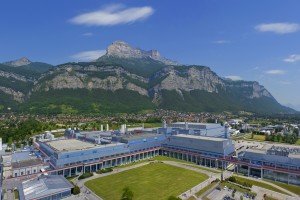The chips reduce timing jitter to 15 femtoseconds making the signals more stable and precise in ways that could increase radar sensitivity, the accuracy of ADCs and the clarity of astronomical images captured by groups of telescopes.
Researchers have taken what was once a tabletop-size system and shrunk much of it into a chip, about the same size as a digital camera memory card. Reducing timing jitter on a small scale reduces power usage and makes it more usable in everyday devices.
Right now, several of the components for this technology are located outside of the chip, as researchers test their effectiveness. The ultimate goal of this project is to integrate all the different parts, such as lasers, modulators, detectors and optical amplifiers, onto a single chip.

To accomplish this, researchers use a semiconductor laser, which acts as a very steady flashlight. They direct the light from the laser into a a reference cavity where some light frequencies are matched to the size of the cavity so that the peaks and valleys of the light waves fit perfectly between the walls.
This causes the light to build up power in those frequencies, which is used to keep the laser’s frequency stable. The stable light is then converted into microwaves using a frequency comb, which changes high-frequency light into lower-pitched microwave signals.
These precise microwaves are crucial for technologies like navigation systems, communication networks and radar because they provide accurate timing and synchronization.
“The goal is to make all these parts work together effectively on a single platform, which would greatly reduce the loss of signals and remove the need for extra technology,” says NIST’s Frank Quinlan. “Phase one of this project was to show that all these individual pieces work together. Phase two is putting them together on the chip.”
In navigation systems such as GPS, the precise timing of signals is essential for determining location. In communication networks, such as mobile phone and internet systems, accurate timing and synchronization of multiple signals ensure that data is transmitted and received correctly.
For example, synchronising signals is important for cell networks to handle multiple phone calls. This precise alignment of signals in time enables the cell network to organize and manage the transmission and reception of data from multiple devices, like your cellphone. This ensures that multiple phone calls can be carried over the network simultaneously without experiencing significant delays or drops.
In radar, which is used for detecting objects like airplanes and weather patterns, precise timing is crucial for accurately measuring how long it takes for signals to bounce back.
“There are all sorts of applications for this technology. For instance, astronomers who are imaging distant astronomical objects, like black holes, need really low-noise signals and clock synchronization,” said Quinlan. “And this project helps get those low noise signals out of the lab, and into the hands of radar technicians, of astronomers, of environmental scientists, of all these different fields, to increase their sensitivity and ability to measure new things
 Electronics Weekly Electronics Design & Components Tech News
Electronics Weekly Electronics Design & Components Tech News



